1998 BUICK PARK AVENUE instrument panel
[x] Cancel search: instrument panelPage 17 of 426
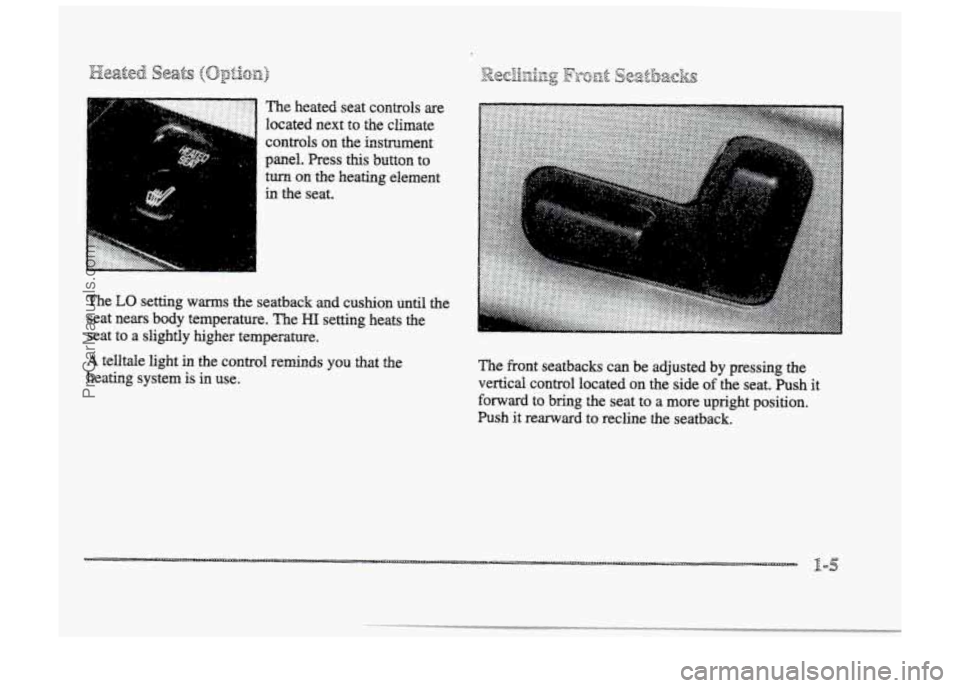
The heated seat controls are
located next to the climate
controls
the instrument
panel. Press
this button to
turn on the heating element
in the seat.
..a ... <-e..
.....
The LO setting warms the seatback and cushion until the
seat nears
body temperature. The HI setting heats the
seat
to a slightly higher temperature.
A telltale light in the control reminds you that the
heating system
is in use.
......
The front seatbacks can be adjusted by pressing the
verticd control located on the side
of the seat. Push it
forward
40 bring the seat to a more upright position.
WPsh it rearward to recline the seatback.
ProCarManuals.com
Page 23 of 426
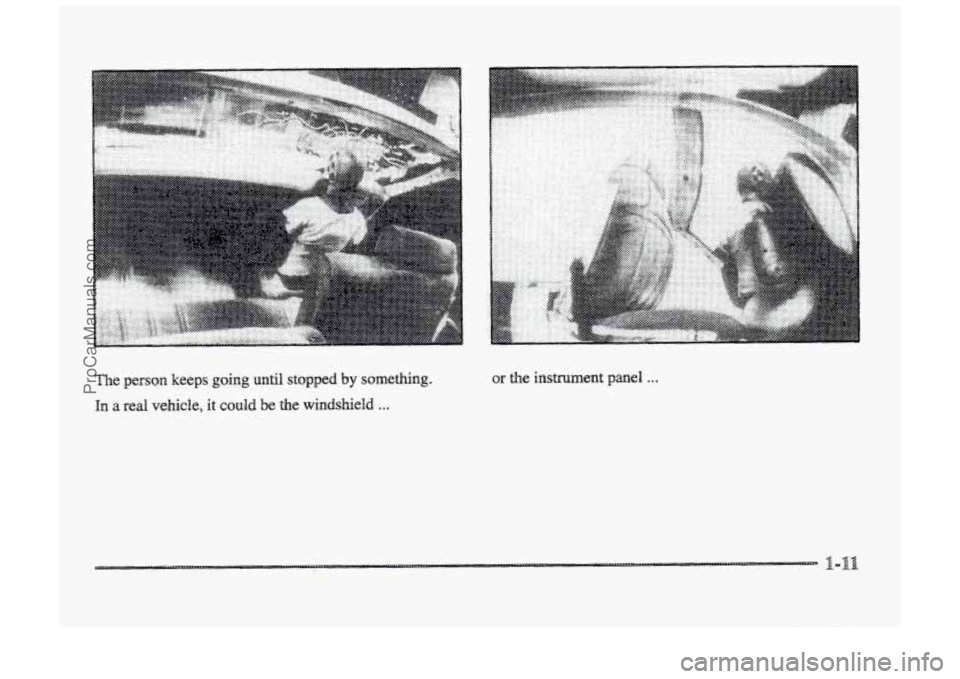
, . . . . . .
The person keeps going until stopped by something.
In a red vebicle, it codd be the windshield ...
or the instrument panel . . .
ProCarManuals.com
Page 35 of 426
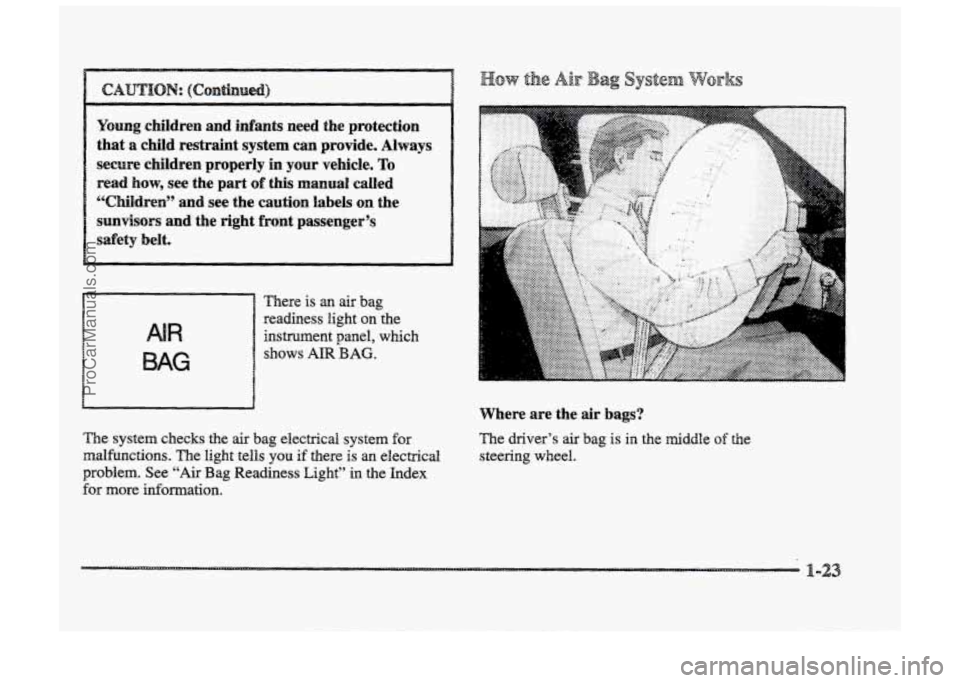
CAmHoN: (CQdIIUd)
Young children and infants need the protection that
a child restraint system can provide. Always
secure children properly in your vehicle.
To
read how, see the part of this manual called
“Children”
and see the caution labels on the
smvisoss and the right front passenger’s
safety belt.
There is an air bag
readiness light
on the
instrument panel, which
BAG
shows AIR BAG.
The system checks the air bag electrical system for
malfunctions. The light
tells YOU if there is an electrical
problem. See
“Air Bag Readiness Light” in the Index
for more information.
..
... ... .; ........
Where are the air bags?
The driver’s air bag is in the middle of the
steering wheel.
ProCarManuals.com
Page 36 of 426
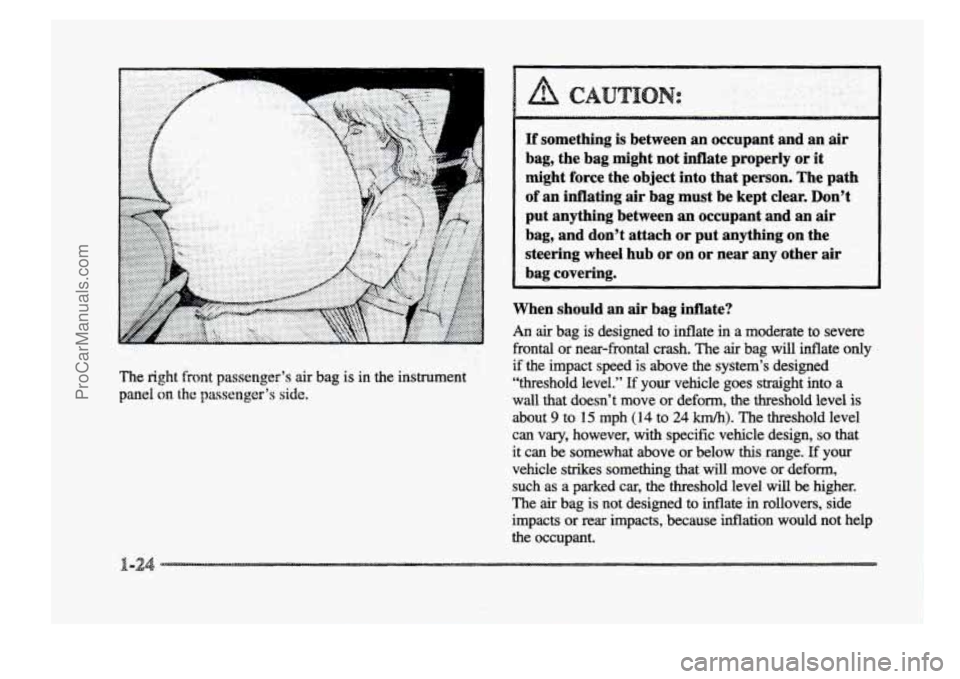
. ..
’ ”I
If something is between an occupant and an air
bag, the bag might not inflate properly or it
might force the object into that person. The path
of an inflating air bag must be kept clear. Don’t
put anything between
an occupant and an air
bag, and don’t attach or put anything on the
steering wheel hub
or on or near any other air
bag ,covering.
The right front passenger’s air bag is in the instrument
panel
an the passenger’s side.
When should an air bag inflate?
An air bag is designed to inflate in a moderate to severe
frontal or near-fiontal crash. The air bag will inflate only
if the impact speed is above the system’s designed
“threshold level.”
If your vehicle goes straight into a
wall that doesn’t move or deform, the threshold level is
about
9 to 15 mph (14 to 24 km/h). The threshold level
can vary, however,
with specific vehicle design, so that
it can
be somewhat above or below this range. If your
vehicle strikes something that
will move or deform,
such
as a parked car, the threshold level will be higher.
The
air bag is not designed to inflate in rollovers, side
impacts or rear impacts, because inflation would not help
the occupant.
ProCarManuals.com
Page 37 of 426
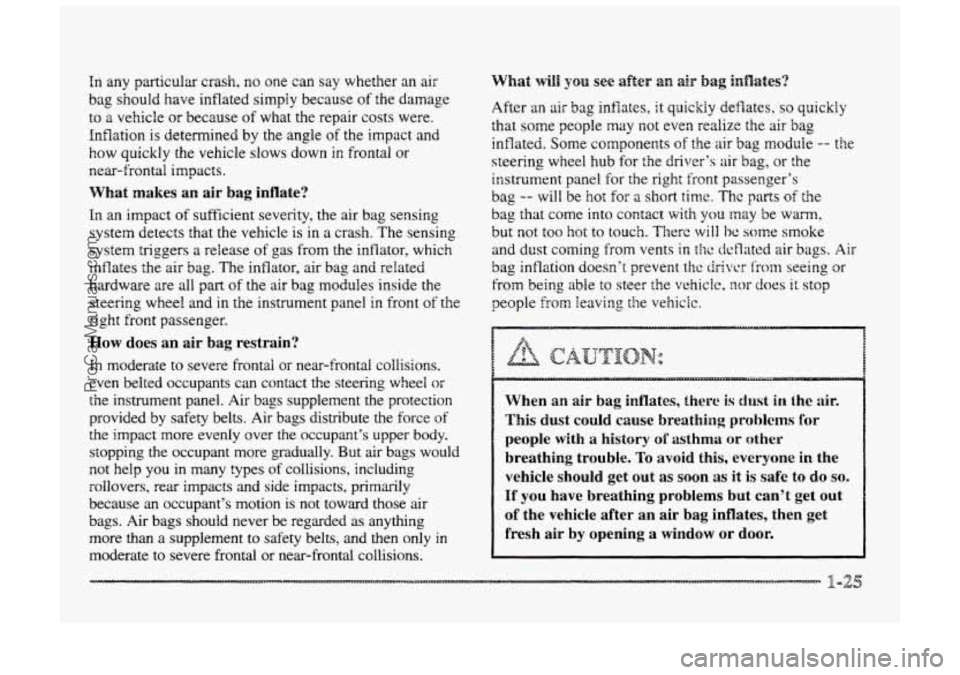
In any particular crash, no one can say whether an air
bag
should have inflated simply because ofthe damage
to
a vehicle or because of what the repair costs were.
Inflation
is determined by the angle of the impact and
how quickly the vehicle slows down
in frontal or
near-frontal impacts.
What makes an air bag inflate?
In an impact of sufficient severity, the air bag sensing
system detects that the vehicle is in a crash. The sensing
system triggers
a release of gas from the inflator, which
inflates the
air bag. The inflator, air bag and related
hardware are
all part of the air bag modules inside the
steering wheel and in the instrument panel in front of the
right front passenger.
How does an air bag restrain?
In moderate to severe frontal or near-frontal collisions,
even belted occupants can contact
the steering wheel or
the instrument panel. Air bags supplement the protection
provided by safety belts. Air bags distribute the force of
the impact more evenly over the occupant’s upper
body.
stopping the occupant more gradually. But air bags would
not help you in many types of collisions, including
rollovers, rear impacts and side impacts, primarily
because an occupant’s motion is not toward those air
bags. Air bags should never be regarded
as anything
more than
a supplement to safety belts, and then only in
moderate
to severe frontal or near-frontal collisions.
What will YQU see after an air bag inflates?
After an air bag inflates, it quickly deflates, so quickly
that
some people may not even realize the air bag
inflated. Some components
of the air bag module -- the
steering wheel hub
for the driver’s air bag, or the
instmrnent panel for the right front passenger’s
bag
-- will be hot for a short time. $he parts of the
bag that corne into contact
with you rnrty be warm,
but not too hot to touch. Therc will bc some smoke
and dust corning
from vents in tlrc rtcBlated air bags. Air
bag inflation doesn’t prevent the ch-iver li.om seeing or
from being able
to steer the vehick. IICX does it stop
people from leaving the vehicic.
When an air bag inflates, there is dust. in the ais.
This dust could cause breathing problerns for
people with a history of asthma or other
breathing trouble. ab avoid this, everyone in the
vehicle should get
out as soon as it is safe to do so.
If you have breathing problems but can’t get out
of the vehicle after an air bag inflates, then get
fresh air by opening a window or door.
ProCarManuals.com
Page 81 of 426
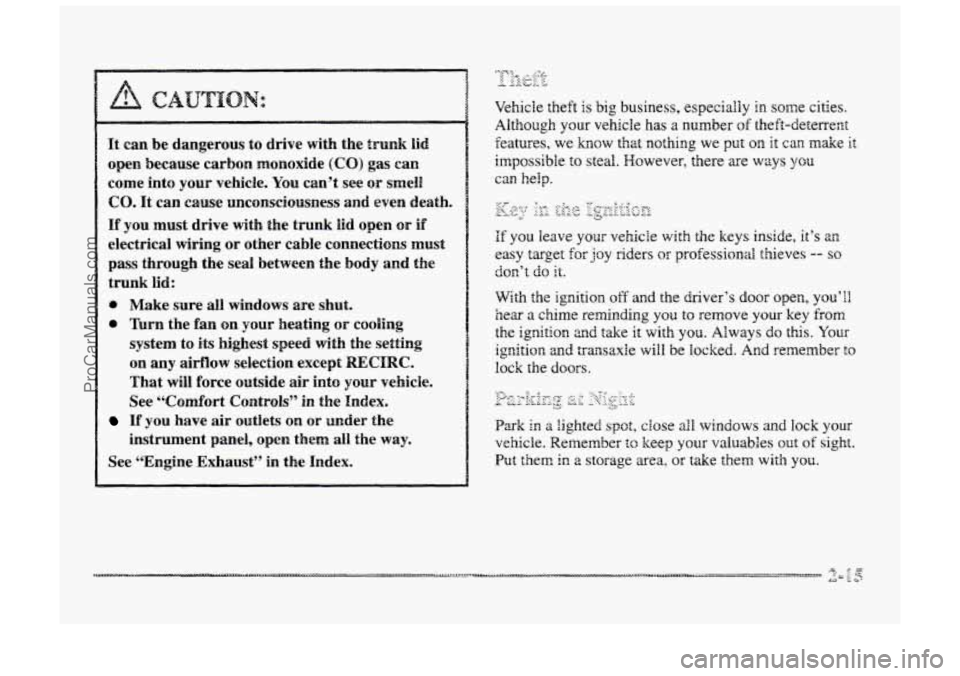
It can be dangerous to drive with the trunk lid
open because carbon monoxide (CO) gas can
come into your vehicle. YOU can’t see or smell1
CO. It can cause unconsciousness and even death.
If you must drive with the trunk lid open OF if
electrical wiring or other cable connections must
pass through the seal between the body and the
trunk lid:
0 Make sure all windows are shut.
Turn the
fan on your heating OF cding
system to its highest speed with the setting
on any airflow selection except RECHWC.
That will force outside air inkt your vehicle.
See
“Comfort Controls” in the Index.
If you have air outiets on or under the
instrument panel, open them all the way.
See “Engine Exhaust’’ in the Index.
.-p->:. . I. !< :. I 1.: ::::, .,,::.-<:. -- :,
Vehicie theft is big business, especiafly in some cities.
Although yaur vehicle has a number of theft-deterrent
features. we
know that nothing we put on kt can make it,
impossible to steal. However, there are wzys you
can help.
.... -
.LL;; , .:.L <,.c;;.;; &iLL&:.< ..I.:- :i4,’ .T”T$,T .:,..-. .?L. >- P .” ..<. :<.:,-.-.
If you leave YQUF vehicle with the keys inside, it’s m
easy target for joy riders or professional thieves -- so
don’t do it.
With the ignition off and the driver’s door open, YQU’IB
hear a chime reminding you to remove your key from
the ignition
md take it with you. Always do tk. Your
ignition and trmsaxie will be Hocked. And remember to
lock the doors.
:;c. 15 ;:,- < FA:. c: Fi, ;- 3;:: c,; ::-$ .:;-
Pa-k in a lighted spot, close all windows and lock your
vehicle. Remember to keep your valuables out of sight.
Put them in a storage area, or take them with you.
. .. . -~ -.&ZL
“7.:. - , ..._ 2 GA &nr2., _v : --;<. ..Ab v 3 .-
ProCarManuals.com
Page 87 of 426
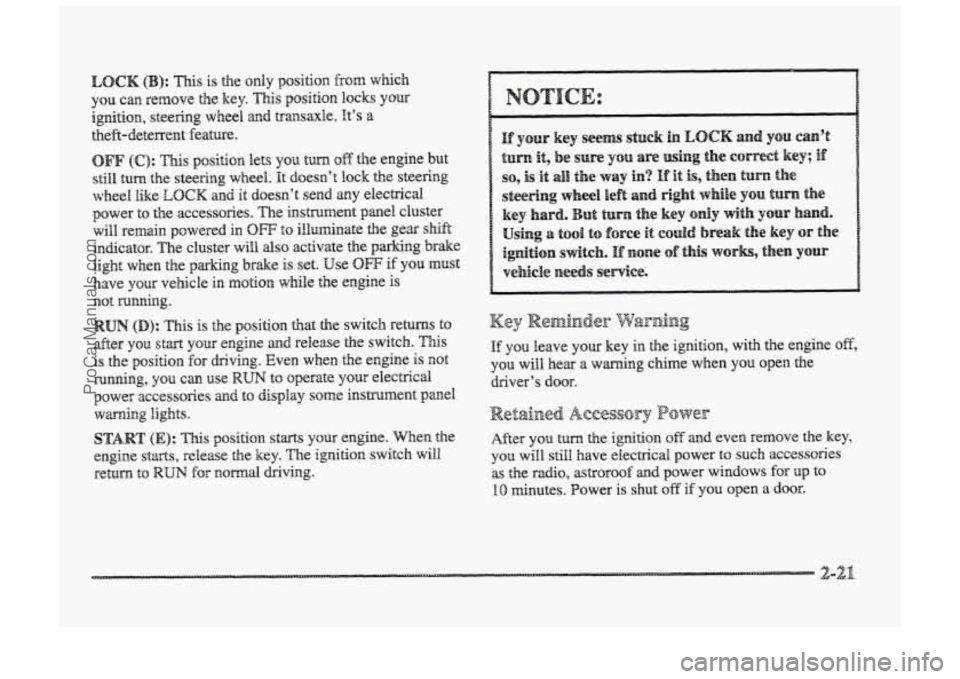
I
LOCK @I: This is the only position from which
YOU can remove the key. This position locks YOU
igition, steering wheel and transaxle. It’s a
theft-deterrent feature.
OFF (C): This position lets YOU turn ofif the engine but
still turn the steering wheel. It doesn’t lock the steering
wrlhee1 like LOCK and it doesn’t send my electrical
power to
the accessories. The instrument panel cluster
will remain powered in OFF to illarminate the gear sWt
indicator. The cluster will also activate the parking brake
fight when the parking brake is set. Use OW if you must
have your vehicle in motion while the engine is
not mnanaing.
RUN (D): This is the position that the switch returns to
after you start YSUP engine and release the switch. This
is &e p~sisi~n for driving. Even when the engine is not
running, you can use RUN to operate your electrical
power accessories anad t~ display some instrument panel
START (E): This position starts your engine. When the
engine
starts, release the key. The ignition switch will
return to RUN for ~a~rrrnal driving.
wdng
lights.
Retained Acces§ory Power
After you turn the ignition off md even remove the key,
you
will still have electrical power to such accessories
as the radio, astroroof ad power windows for up to
10 minutes. Power is shut off if you open a door.
2-21
ProCarManuals.com
Page 112 of 426

Whew it’s dark enough outside, your high-$em
headlamps will change
to low-beam headlamps at full
brightness. The other lamps that turn with your
headlamps will also turn on. When it’s bright enough
outside, the regular
Imps will turn off, and your
high-beam headlamps change
to the reduced brightness
Qf DWL.
To turn off all exterior lighting at night when YOU are
parked,
tlrm off the headlamps and move the twilight
sentinel
~ontd to the left into the detent in the slider
control. When released, the control
will return to the
Twilight Sentinel minimum delay position and the fights
will turn off.
As with any vehicle, YOU should turn on the regular
headlamp system
when YOU need it.
To operate this feature, slide
the control
to any position
to vary the lamp timeout.
If you move the control a11 the way to MAX, your lamps
will remain on for three minutes after you turn off your
engine. If you move the control almost all the way in the
other direction, so it’s just on, the Imps will go off
quickly when you turn off your engine. You cm set this
delay time
from only a few seconds to thee lminutes.
YQU~ twilight sentinel and daytime running lamps work
with
the Bight sensor on top of the instrument panel.
Don’t cover it
up- If you do it will read “dark” and the
headlamps
will come on.
ProCarManuals.com